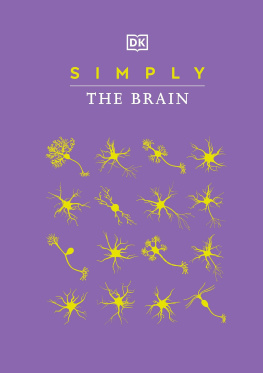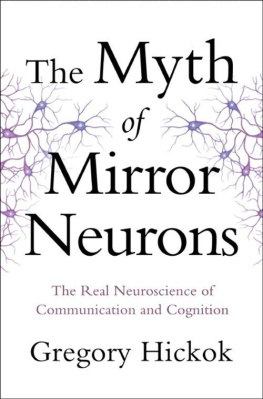This book would not have been possible without the help, encouragement, and support of many friends and colleagues. First and foremost I thank John Brockman for his unfaltering encouragement to write it. I also thank Katinka Matson, Mike Bryan, and my editor, Eric Chinski, for shaping the manuscript in many important ways.
Several people read individual chapters from early and late drafts of the book. I am grateful to George Lakoff, Sam Harris, Annaka Harris, Frank Vincenzi, Sally Rogers, Kelsey Laird, Amy Coplan, Lisa Aziz-Zadeh, Elizabeth Reynolds, Julian Keenan, Alan Fiske, John Mazziotta, Giacomo Rizzolatti, and Vittorio Gallese for their comments, suggestions, and questions.
A common thread of the book is the research that has been performed in my lab in the last ten years. This research has been possible because of the dedication and enthusiasm of colleagues and trainees. First and foremost, I am in debt to Giacomo Rizzolatti and Vittorio Gallese, wonderful friends and colleagues who participated in seminal experiments performed in my lab. John Mazziotta, Roger Woods, Harold Bekkering, Marcel Brass, Andreas Wohlschlger, Eran Zaidel, Gian Luigi Lenzi, Patricia Greenfield, and Itzhak Fried also participated in crucial experiments on the human mirror neuron system. With her own lab, my wife and colleague, Mirella Dapretto, led groundbreakingresearch on mirror neuron dysfunction in autism, and I was fortunate to collaborate on these studies.
I celebrate my trainees, who have enriched my life in many ways. Mentoring and doing experiments with them has been illuminating and exhilarating: Lisa Aziz-Zadeh, Laurie Carr, Choi Deblieck, Marie-Charlotte Dubeau, Marc Heiser, Jonas Kaplan, Lisa Koski, Ingo Meister, Istvan Molnar-Szakacs, Roy Mukamel, Darren Schreiber, Lucina Uddin, Stephen Wilson, and Allan Wu were involved in experiments and endless discussions on how mirror neurons shape our social behavior.
With leadership and vision, John Mazziotta created a wonderful research facilitythe Ahmanson-Lovelace Brain Mapping Centerwhere my lab is located. I celebrate John and the center and feel fortunate to do my research in such a world-class facility. I thank the UCLA Semel Institute for Neuroscience and Human Behavior and the FPR-UCLA Center for Culture, Brain, and Development for creating extraordinarily stimulating environments where I often discussed the role of mirror neurons in human behavior.
In the last ten years, I have given seminars on mirror neurons all over the world. I thank all the people who came to hear me speak, asked me questions, and gave me comments. All those people helped in shaping the arguments I put in this book. I am deeply grateful to them.
I am writing this afterword on Inauguration Day. These are days of high hope, the hope that Barack Obamas campaign and presidential election have so brilliantly raised in all of us. Amazingly, in his first speech as President, Obama has said that he wants to restore science to its rightful place. Obviously, I couldnt agree more. Mirroring People also ends on a hopeful note, the hope that science and scientific thinking may play an important role in our society.
The purpose of this afterword is to provide a brief update on the scientific progress and research on mirror neurons from the past year. Science obviously never stops; every month the results of new experiments are announced at scientific conferences and new scientific papers are published in specialized journals. A book, however, is written over a long period of time, and the abundance of new data, new findings, and new interpretations that had emerged during the writing of MirroringPeople presented a challenge to me. I asked myself many times as the manuscript entered the final stages of editing: Should I include these new results at the cost of altering the structure of the argument, or the rhythm of the book? Luckily, I am no longer in that rather uncomfortable situation, and this afterword, written in a compressed time frame, is only intended to serve as a snapshot of the most important research findings that have appeared since I finished the book.
There have been so many different studies that I cannot possibly summarize them all, which perhaps is testimony to the fact that there is a lot of excitement in the neurosciences about mirror neurons. Indeed, research on neural mirroring has begun to expand beyond primates. Two recent scientific articles published in the highly regarded journal Nature have reported the existence of auditory-vocal mirror neurons in songbirds, suggesting that these cells may be critical for songbird learning. I expect many more studies on mirror neurons in non-primates in the future, and that these studies will be extremely important to understanding the role of mirror neurons in animal behavior. In this afterword, however, I will focus on studies in monkeys and humans, and in particular will highlight research trends that illustrate our understanding of mirror neurons and our social brain.
There are three major trends in mirror neuron research today. One includes studies that investigate what we scientists call individual differences. Some pioneering studies of this kind have been already discussed in the book, specifically those that investigated the reduced activity of the mirror neuron system in patients with autism, and how it correlates withthe severity of autism; or the studies that looked at mirror neuron activity among adolescents or healthy adults and correlated it with a variety of measures of social competence and empathy. Many studies of this kind have been presented at conferences recently. They correlate a variety of personality and psychological measures with activity in mirror neuron areas. The more we learn about the system in our brain, the more it seems a cornerstone of our ability to socialize with others. It is too early to draw strong conclusions or to summarize many of the findings in a few sentences, but there is definitely a sense that we may soon reach an amazing understanding of the biological foundations of our most complex behaviorthat is, our social behavior.
The second trend relates to the development of the mirror neuron system. It is extremely important to understand how mirror neurons are formed early on in life, and which factors favor a healthy development of these cells. Many colleagues share my belief, and they are trying to investigate the mirror neuron system in the infant brain. Unfortunately, for many technical and ethical reasons, it is difficult to conduct these kinds of experiments. The most promising study on the mirror neurons system in the infant brain is currently being performed in the lab of Steve Suomi at NIH. The scientist leading this study is Pier Francesco Ferrari, the ethologist and neurophysiologist who led the experiment on mirror neurons and tool-use described in the first chapter of this book. Ferrari is studying baby monkeys from their very first few days of life, using EEG and behavioral observations. At this time, Ferrari, Suomi, and their colleagues have not yet published their findings.Ferrari, however, presented some preliminary observations at two small conferences I attended in the last few months. Two of his findings are particularly intriguing. First, Ferrari and his colleagues looked at the ability of the infant monkey to imitate. In this experiment, the baby monkeys were prevalently imitating relatively simple facial expressions, for instance tongue protrusion, as in the study on human infants led by Meltzoff that I described in the second chapter of the book. Ferrari and his colleagues found that some infant monkeys are good imitators, whereas others do not imitate well at all. This is not really surprising. Monkeys, and humans too, of course, all differ from one another to some degree. The fundamental question, however, is whether being a good imitator very early in life facilitates learning. The scientists found that the good imitators developed the ability to grasp objects earlier and better than the bad imitators. This result confirms not only how important imitative learning is early in life, but also how hand and mouth are tightly coupled in the brain, as discussed in chapter 3.











